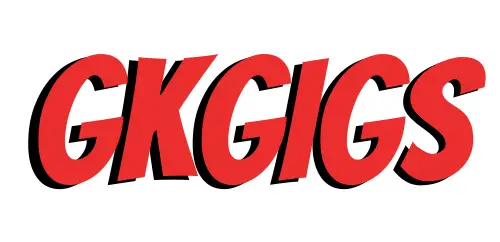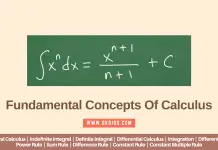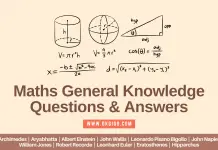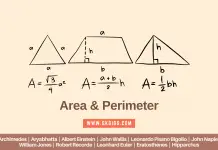
Last Updated: 30 November 2023
If you’re looking for exercise questions on Profit, Loss, Discount, And Tax, you have come to the right place.
In this article, you will find 100+ Questions related to Profit Loss Discount and Tax answered in simple English language for you to understand easily.
This exercise question is taken from R.S. Aggarwal’s Class 8 ICSE Book and the contents are separated exercise-wise to differentiate between different types of questions.
Profit Loss Discount and Tax is a very important chapter, especially for those sitting for Mathematics Aptitude, Bank Exams, Economics, School Exams, and Competitive Exams.
Read the following concepts and solve the exercise questions. 25 MCQ questions are provided at the end for you to test your brain.
Page Contents
Review of Concepts
Cost Price (C.P.)= The price at which an article is purchased is called its Cost Price.
Selling Price (S.P.)= The price at which an article is sold is called its Selling Price.
Overhead Expenses= Sometimes apart from paying the cost of an article a person has to spend money on transportation, labor charges, repair, sales tax, etc. Such expenses are known as Overhead Expenses
Marked Price (M.P.)= In big shops and departmental stores, every article is tagged with a card, and its price is written on it. This is called the Marked Price of that article, abbreviated as M.P.
List Price= Items that are manufactured in a factory are marked with a price according to the list supplied by the factory at which the retailer is supposed to sell them. This price is known as the List Price of the article.
Discount= In order to give a boost to the sale of an item or to clear the old stock sometimes the shopkeeper offer a certain percentage of rebate on the marked price. This is known as a Discount.
Successive Discount= Suppose a 20% discount is given on the marked price of an article and further, a discount of 10% is given at the reduced price. Then we can say that discounts of 20% and 10% are given in the article.
Tax= A compulsory contribution to the state revenue, levied by the government and added to the cost of goods and services is called Tax. It is always reckoned as a percentage of the sale.
Difference between Marked Price and Sale Price= The price marked on an article is called its Marked Price or List Price whereas the price at which an article is offered to the customer is called the Sale Price.
| Important Formulas 1) Gain= S.P. – C.P. 2) Gain%= (Gain/C.P.)*100 3) Loss= C.P. – S.P. 4) Loss%= (Loss/C.P.)*100 |
Ex-7A
1. Find the Gain Percent or Loss Percent, when:
(i) C.P.= ₹750, S.P.= ₹875 (ii) C.P.= ₹126, S.P= ₹94.50
(iii) C.P.= ₹80.40, S.P= ₹68.34 (iv) C.P.= ₹58.75, S.P= ₹51.70
Solution:
(i) C.P.= ₹750 and S.P.= ₹875
∴ Gain= S.P. – C.P. = ₹(875-750)= ₹125
Now Gain%= (125/750) * 100= 16.67%
(ii) C.P.= ₹126, S.P= ₹94.50
∴ Loss= C.P. – S.P. =₹(126-94.50)= ₹31.50
Now Loss%= (31.50/126) * 100= 25%
(iii) C.P.= ₹80.40, S.P= ₹68.34
∴ Loss= C.P. – S.P. =₹(80.40 – 68.34)= ₹12.06
Now Loss%= (12.06/80.40) * 100= 15%
(iv) C.P.= ₹58.75, S.P= ₹51.70
∴ Loss= C.P. – S.P. =₹(58.75 – 51.70)= ₹12.06
Now Loss%= (7.05/58.75) * 100= 12%
2. Ranjit Purchased an almirah for ₹5,248 and paid ₹127 for its transportation. He sold it for ₹6,020. Find his Gain Percent or Loss Percent?
Solution: C.P. of an almirah= ₹5248
Spent on transportation= ₹127
Net C.P. of almirah= ₹(5248+127) =₹5375
S.P. of almirah= ₹6020
Gain= ₹(6020-5375) =₹645
Gain%= (645/5375) * 100= 12%
3. Ahmed purchased an old scooter for ₹14,625 and spent ₹3,225 on its repairs. Then, he sold it for ₹16,422. Find his Gain Percent or Loss Percent
Solution: C.P. of an old scooter= ₹14625
Spent on repair= ₹3225
Net C.P. of an old scooter= ₹(14625+3225)= ₹17850
S.P. of an old scooter= ₹16422
Loss= ₹(17850-16422)= ₹1428
Loss%= (1428/17850) * 100= 8%
4. A man buys two cricket bats, one for ₹1,360 and the other for ₹1,040. He sells the first bat at a gain of 15% and the second one at a loss of 15%. Find his Gain Percent or Loss Percent in the whole transaction?
Solution: C.P. of first bat= ₹1360
Gain%= 15%
S.P.= C.P. * (100+Gain%)/100= 1360 * (100+15)/100= ₹1564
C.P. of the second bat= ₹1040
Loss%= 15%
S.P.= C.P. * (100-Loss%)= 1040 * (100-15)/100= ₹884
∴ Total C.P. = ₹(1564+884)= ₹2448
Total S.P. =₹(1360+1040)= ₹2400
∴ Gain= S.P. – C.P. = ₹(2448-2400)= ₹48
Gain %= (48/2400) * 100= 2%
5. Nandlal bought 20 dozen notebooks at ₹156 per dozen. He sold 8 dozen of them at a 10% gain and the remaining 12 dozen at a 20% gain. What is his Gain Percent in the whole transaction?
Solution: C.P. per dozen= ₹156
C.P. of 20 dozen notebooks= 156 * 20= ₹3120
C.P. of 8 dozen notebook= 156 * 8= ₹1248
Gain= 10% of 1248= 124.80
S.P. of 8 dozen notebooks= 1248 + 124.80= ₹1372.80
Now C.P. of 12 dozen notebooks= 156 * 12= ₹1872
Gain= 20% of 1872= ₹374.40
S.P. of 12 dozen notebooks= 1872 + 374.40= ₹2246.40
Total S.P. of 20 dozen notebooks= 1372.80 + 2246.40= ₹3619.20
Total Gain= 124.80 + 374.40= ₹499.20
∴ Gain%= (499.20/3120) * 100= 16%
Related: Maths Quiz Multiple Choice Questions On Algebra
6. Heera bought 25Kg of rice at ₹48 per Kg and 35Kg of rice at ₹60 per Kg. He sold the mixture at ₹66 per Kg. Find his Gain Percent?
Solution: C.P. of 1 Kg rice= ₹48
C.P. of 25 Kg rice= 25 * 48= ₹1200
C.P. of another 1 Kg rice= ₹60
C.P. of 35 Kg rice= 60 * 35= ₹2100
C.P. of (25+35=60) Kg rice= ₹1200 + ₹2100= ₹3300
Now S.P. of 1 Kg rice= ₹66
∴ S.P. of 60 Kg rice= 66 * 60= ₹3960
Gain= S.P. – C.P. = 3960 – 3300= ₹660
Gain%= (660/3300) * 100= 20%
7. If the selling price of an article is (4/5)th of its cost price, Find the Loss Percent?
Solution: C.P. = x
S.P. = (4/5)x
Loss= x – (4x/5)= x/5
Loss%= (x/5)/x *100= 20%
8. If the selling price of an article is 11⁄3 of its cost price, find the Gain Percent?
Solution: C.P.= x
S.P.= 4x/3
Gain= (4x/3) – x= x/3
Gain%= (x/3)/x * 100= 100/3% = 331⁄3%
9. A man sold a table for ₹2,250 and gained one-ninth of its cost price. Find
(i) Cost Price of the table (ii) Gain Percent earned by the man
Solution: S.P= ₹2250
C.P.= x
Gain= 1/9
C.P. = (1/9)x
S.P. = C.P. + Gain= x + (1/9)x = 10x/9
So, 10x/9 = ₹2250
x= 2025
(i) Cost Price= ₹2025
(ii) Gain= S.P. – C.P. = ₹225
Gain% = (225/2025) * 100= 100/9 = 11.11%
10. By selling a pen for ₹195, a man loses one-sixteenth of what it cost him. Find (i) Cost Price of the pen (ii) Loss Percent
Solution: S.P. = ₹195
C.P. = x
Loss= 1/16
C.P. = 1/16 * x = x/16
S.P. = C.P. – Loss = x – x/16 = 15x/16
So, 15x/16 = 195
x= ₹208
Now C.P. = ₹208
Loss= 208 * 1/16 = ₹13
Loss%= (13/208) * 100 = 25/4% = 6.25%
11. A cycle was sold at a gain of 10%. Had it been sold for ₹99 more, the gain would have been 12%. Find the Cost Price of the cycle?
Solution: Let the cost price of the cycle = ₹x
Gain = 10%
We know that Selling price = [(100 + Gain%)/100] * CP= [(100 + 10)/100] * x
= [110/100] * x = 110x/100 = 11x/10
ATQ, it had been sold for ₹99 more
Selling price = ₹(11x/10) + 99 ——(1)
The gain would have been 12%
Selling Price = [(100 + Gain%)/100] * CP= (112/100) * x
= 112x/100 = ₹28x/25 ——(2)
On solving (1) & (2), we get
=> (28x/25) = (11x/10) + 99
=> (28x/25) – (11x/10) = 99
=> (56x – 55x) = 99 * 50
=> x = ₹4950
Therefore, the Cost Price of cycle = ₹4950
12. A bucket was sold at a loss of 8%. Had it been sold for ₹56 more, there would have been a gain of 8%. What is the Cost Price of the bucket?
Solution: Let the C.P. of bucket= ₹x
Loss= 8%
S.P. = [(100 – 8) * x]/100
S.P. = 92x/100
Now, it had been sold for ₹56 more
S.P.= (92x/100)+56
Gain% = 8%
S.P.= (100+8) * x/100
Difference between two S.P.’s= ₹56
=> (108x/100) – (92x/100)= 56
=> 16x = 56 * 100
=> x= (56 * 100)/16
=> x= 350
∴ Cost Price of the bucket is ₹350
13. The selling price of 18 books is equal to the cost price of 21 books. Find the Gain Percent or Loss Percent?
Solution: Given, S.P. of 18 Books = C.P. of 21 Books
Let the Cost Price of 21 books = a
Cost Price of 1 book = a/21
Selling Price of 18 book = a
Selling Price of 1 book = a/18
Gain on 1 book = S.P. – C.P. = a/18 – a/21 = (7a – 6a)/126 = a/126
Now, Gain% = (Gain on 1 book * 100) / C.P. of 1 book
= (a/126) * 100/( a/21) = 100 * 21/126 = 100/6 = 16.67 %
14. The cost price of 12 fans is equal to the selling price of 16 fans. Find the Gain percent or Loss Percent?
Solution: Given, C.P. of 12 fans = S.P. of 16 fans
Let the Cost Price of 12 fans = a
Cost Price of 1 fan = a/12
Selling Price of 16 fans = a
Selling Price of 1 fan = a/16
Loss on 1 fan = C.P. – S.P. = (a/12) – (a/16) = (4a – 3a)/48 = a/48
Loss% = (Loss/CP) * 100 = (a/48)/(a/12) * 100 = 100/4 = 25%
15. On selling 250 cassettes, a man had gain equal to the selling price of 25 cassettes. Find the Gain Percent?
Solution: Let S.P. of 1 Cassette= ₹100
S.P. of 25 Cassette= 100 * 25 = ₹2500
S.P. of 250 Cassette= 100 * 250 = ₹25000
C.P. of 250 Cassette= S.P. of 250 Cassette – Gain of 25 Cassette = 25000 – 2500 = ₹22500
Gain%= (2500/22500) * 100 = 11.11%
Related: Area And Perimeter Multiple Choice Questions (CBSE & ICSE)
16. On selling 36 oranges, a vendor loses the selling price of 4 oranges. Find his Loss Percent?
Solution: Let S.P. of 1 orange= ₹1
S.P. of 36 oranges= 1 * 36 = ₹36
S.P. of 4 oranges= 1 * 4 = ₹4
C.P. of 35 oranges = S.P. of 36 oranges + Loss = 36 + 4= ₹40
Loss%= (4/40) * 100 = 10%
17. Toffees are bought at 2 for a rupee and sold at 5 for ₹3. Find the Gain Percent or Loss Percent?
Solution: Let C.P. of 2 Toffees= ₹1
C.P of 1 Toffee= ₹1/2
S.P of 5 Toffees= 3
S.P. of 1 Toffee= ₹3/5
Gain= S.P. – C.P. = (3/5) – (1/2) = 1/10
Gain%= (1/10)/(1/2) * 100 = 20%
18. Coffee costing ₹450 per Kg was mixed with chicory costing ₹225 per Kg in the ratio of 5:2 for a certain blend. If the mixture was sold at ₹405 per Kg. Find the Gain Percent or Loss Percent?
Solution: C.P. of 1 Kg coffee= ₹450
C.P. of 5 Kg coffee= 450 * 5 = ₹2250
C.P. of 1 Kg chicory= ₹225
C.P. of 2 Kg chicory= 225 * 2 = ₹430
Now, C.P. of (5+2) Kg mixture= 2250 + 450 = ₹2700
Now, S.P. of 1 Kg of mixture= ₹405
∴ S.P. of 7 Kg mixture= 405 * 7 = ₹2835
Gain = 2835 – 2700 = ₹135
Gain% = (135/2700) * 100 = 5%
Extra
19. A man buys an article for ₹55 and sells it for ₹63.80. Find the Gain or Loss Percent?
Solution: C.P.= ₹55 and S.P.= ₹63.80
Since S.P.>C.P. so there is a Gain
Gain= S.P. – C.P= ₹(63.80-55)= ₹8.80
∴ Gain%= {(8.80/55)*100}%= 16%
20. A shopkeeper bought a bat for ₹490 and sold it for ₹416.50. Find his Gain or Loss Percent?
Solution: C.P.= ₹490 and S.P.= ₹416.50
Since C.P.>S.P. so there is a Loss
Loss= C.P. – S.P.= ₹(490-416.50)= ₹73.50
∴ Loss%= {(73.50/490)*100)%= 15%
21. A shopkeeper purchased a T.V. set for ₹2960 and spent ₹595 on its repairs and ₹120 on its transportation. He then sold it for ₹4557. Find his gain percent?
Solution: C.P.= ₹2960
Overhead expenses= ₹(595+120)= ₹715
Actual C.P.= C.P. + Overhead expenses= ₹(2960+715)= ₹3675
S.P.= ₹4557
Since S.P.>C.P. so there is a Gain
Gain= S.P. – C.P.= ₹(4557-3675)= ₹882
∴ Gain%= {(882/3675)*10}%= 24%
22. A man bought oranges at 8 for ₹34 and sold them at 12 for ₹57. Find his Gain or Loss Percent?
Solution: C.P. of 8 oranges= ₹34
C.P. of 1 orange= ₹(34/8)
C.P. of 24 oranges= ₹{(34/8)*24}= ₹102
S.P. of 12 oranges= ₹57
S.P. of 1 orange= ₹(57/12)
S.P. of 24 oranges= ₹{(57/12)*24}= ₹114
Since S.P.>C.P. so there is a Gain
Gain= ₹(114-102)= ₹12
∴ Gain%= {(12/102)*100}%= 200/17%= 11.76%
23. If the cost Price of 10 articles is equal to the selling price of 8 articles. Find the Gain or Loss Percent?
Solution: Let the cost price of each article be ₹x. Then,
C.P. of 8 articles= ₹8x
S.P. of 8 articles= C.P. of 10 articles= ₹10x
Since S.P.>C.P. so there is a Gain
Gain= ₹10x-8x= ₹2x
∴ Gain%= {(2x/8x)*100}%= 25%
24. By selling 33 meters of cloth, One gains the selling price of 11 meters. Find the Gain percent?
Solution: Given, Gain on selling 33m= (S.P. of 33m) – (C.P. of 33m)
=> S.P. of 11m= (S.P. of 33m) – (C.P. of 33m)
=> C.P. of 33m= (S.P. of 33m) – (S.P. of 11m)
=> C.P. of 33m= S.P. of 22m
Let the C.P. of each metre of cloth be ₹x. Then,
C.P. of 22m = ₹22x
S.P. of 22m= C.P. of 33m= ₹33x
Gain on 22m of cloth= S.P.- C.P. = ₹(33x-22x)= ₹11x
∴ Gain%= {(11x/22x)*100}= 50%
25. A T.V. set was sold at a gain of 15%. Had it been sold for ₹575 more, the gain would have been 20%. Find the cost price of the set?
Solution: Let the cost price if the T.V. set be ₹x
When the gain is 15%, the S.P.= ₹(x+15% of x)= ₹23x/20
When the gain is 20%, then S.P.= ₹(x+20% of x)= ₹6x/5
Now, the difference between the two S.P.’s= ₹575
ATQ, (6x/5) – (23x/20)= 575
x= 11500
∴ The cost price of the set is ₹11500
Related: Time And Distance Multiple Choice Questions (Boost Your IQ)
Ex-7B
| To find S.P. when Gain Percent or Loss Percent are given 1) S.P.= {(100+Gain%)/100} * C.P. 2) S.P.= {(100-Loss%)/100} * C.P. To find C.P. when S.P. and Gain Percent or Loss Percent are given 3) C.P.={(100/(100+Gain%)} * S.P 4) C.P.={(100/(100-Loss%)} * S.P |
1) Find the Selling Price when:
(i) C.P.= ₹7,640, Gain= 15% (ii) C.P.= ₹4,850, Loss= 17%
(iii) C.P.= ₹720, Loss= 35/4% (iv) C.P.= ₹2,652, Gain= 50/3%
Solution:
(i) C.P.= ₹7,640, Gain= 15%
S.P.= (100+Gain%)/100*C.P.= (100+15)/100*7640= ₹8786
(ii) C.P.= ₹4,850, Loss= 17%
S.P.= (100-Loss%)/100*C.P.= (100-12)/100*4850= ₹4268
(iii) C.P.= ₹720, Loss= 35/4%
S.P.= (100-Loss%)/100*C.P.= (100-35/4)/100*720= ₹657
(iv) C.P.= ₹2,652, Gain= 50/3%
S.P.= (100+Gain%)/100*C.P.= (100+50/3)/100*2652= ₹3094
2. Find the Cost Price when:
(i) S.P.= ₹207, Gain= 15% (ii) S.P.= ₹448.20, Loss= 17%
(iii) S.P.= ₹1,479, Gain= 25/4% (iv) S.P.= ₹611.80, Loss= 8%
Solution:
(i) S.P.= ₹207, Gain= 15%
C.P.= 100/(100+Gain%)*S.P.= 100/(100+15)*207= ₹180
(ii) S.P.= ₹448.20, Loss= 17%
C.P.= 100/(100-Loss%)*S.P.= 100/(100-17)*448.20= ₹540
(iii) S.P.= ₹1,479, Gain= 25/4%
C.P.= 100/(100+Gain%)*S.P.= 100/(100+25/4)*1479= ₹1392
(iv) S.P.= ₹611.80, Loss= 8%
C.P.= 100/(100-Loss%)*S.P.= (100/100-8)*611.80= ₹665
3. A sells a bicycle to B at a profit of 20% and B sells it to C at a profit of 5%. If C pays ₹3,780, what did A pay for it?
Solution: C’s C.P. = ₹3780 or B’s S.P.= ₹3780
Gain= 5%
B’s C.P.= 100/(100+Gain%)*S.P.= 100/(100+5)*3780= ₹3600
A’s S.P.= ₹3600
A’s Gain= 20%
A’s C.P.= 100/(100+20)*3600= ₹3000
Hence A paid ₹3000 for the bicycle
4. Raju sold a watch to Sonu at a 12% gain and Sonu had to sell it to Manu at a loss of 5%. If Manu paid ₹5,320, How much did Raju pay for it?
Solution: Raju’s C.P.= x
Profit%= 12%
S.P.= (100+12)/100*x= ₹28x/25
Sonu’s C.P.= ₹28x/25
Loss%= 5%
S.P.= (100-5/100)*28x/25= ₹133x/125
Manu’s C.P.= ₹133x/125
But given C.P.= ₹5320
∴ 133x/125 = 5320
or, x= ₹5000
Raju paid ₹5000 for the watch
5. A grocer purchase 80 Kg of rice at ₹27 per Kg and mixed it with 120 Kg of rice purchased at ₹32 per Kg. At what rate per Kg should he sell the mixture to gain 16%?
Solution: C.P. of 80 kg rice at ₹27 per kg= 27*80= ₹2160
C.P. of 120 kg rice at ₹32 per kg= 32*120= ₹3840
So, C.P of (80+120=200)kg rice= 2160+3840= ₹6000
Gain%= 16%
∴ S.P. of 200 kg rice= (100+16)/100*6000= ₹6960
Also S.P. of 1 kg rice= 3480/100= ₹34.80 per kg
6. Mrs. Harjeet bought two bags for ₹1,150 each. She sold one of them at a gain of 6% and the other at a loss of 2%. How much did she gain?
Solution: C.P of each bag= ₹1150
C.P. pf 2 bags= 1150*2= ₹2300
Now C.P. of first bag= ₹1150
Gain%= 6%
S.P.= (100+6)/100*1150= ₹1219
Now C.P. of second bag= ₹1150
Loss= 2%
S.P. = (100-2)/100*1150= ₹1127
S.P. of 2 bags= 1219+1127= ₹2346
∴ Gain= 2346-2300= ₹46
7. A trader purchased a wall clock and a watch for a sum of ₹5,070. He sold them making a profit of 10% on the wall clock and 15% on the watch. He earns a profit of ₹669.50. Find the cost price of the wall clock and that of the watch?
Solution: Let C.P. = x
Gain = 10%
S.P.= (100+Gain%)/100*C.P.= (100+10)/100*x= ₹11x/10
Gain= (11x/10)-x= x/10
C.P.= (5070-x)
Gain= 15%
S.P.= (100+15)/100*(5070-x)
Gain= (23/20)*(5070-x) – (5070-x)= (3/20)*(5070-x)
Total Gain= x/10 + (3/20)*(5070-x) = (15210-x)/20
Given Profit= ₹669.50
∴ (15210-x)/20 = 669.50
x= 1820
So, C.P. of wall clock = 1820
C.P. of watch= 5070-1820= ₹3250
8. Toffees are bought at 15 for ₹20. How many toffees would be sold for ₹20 so as to gain 25%?
Solution: C.P. of 15 toffees= ₹20
Gain%= 25%
S.P.= (100+25)/100*20= ₹25
Now for ₹20, 15 toffees are sold
So, for ₹20 the number of toffees sold will be= 15*20/25= 12 toffees
9. Two-thirds of a consignment was sold at a profit of 5% and the remainder at a loss of 2%. If the total profit was ₹4,000. Find the value at which the consignment was purchased?
Solution: Let C.P. = x
Valu of 2/3 consignment= ₹2x/3
Gain%= 5%
Total Gain= (2x/3)*(5/100)= x/30
Value of 1/3 consignment= 1x/3
Loss%= 2%
Total Loss= (x/3)*(2/100)= x/150
Net gain= Total Gain – Total Loss = (x/30) – (x/150) = 4x/150
Given Total Profit= ₹4000
∴ 4x/100 = 4000
x= ₹150000
The value of total consignment= ₹1,50,000
10. A grocer bought sugar worth ₹4,500. He sold one-third of it at a 10% gain. At what gain percent the remaining sugar be sold to have a 12% gain on the whole transaction?
Solution: C.P. of sugar= ₹4500
C.P. of 1/3 part= ₹4500*1/3 = ₹1500
Gain%= 10%
S.P. of 1/3 part= (100+10)/10*1500= ₹1650
Gain on total sugar= 12%
Total S.P.= (100+12)/100*4500= ₹5040
S.P. of remaining 2/3 sugar= 5040 – 1650= ₹3390
C.P. = 4500-1500= ₹3000
∴ Gain= 3390-3000= ₹390
Now Gain%= (390/3000)*100= 13%
Related: Exponents And Powers Multiple Choice Questions (CBSE & ICSE)
11. A man buys a piece of land for ₹3,84,000. He sells two-fifths of it at a loss of 6%. At what gain percent should he sell the remaining piece of land to gain 10% on the whole transaction?
Solution: C.P. of land= ₹3,84,000
C.P. of 2/5 part of it= 2/5*384000= ₹153600
Loss%= 6%
S.P.= (100-Loss%)/100*C.P. = (100-6)/100*153600 = ₹144384
C.P.= 384000 – 153600= ₹230400
Gain on the whole transaction= 10%
So, S.P. of the whole piece of land= (100+10)/100*384000= ₹422400
S.P. of the remaining piece of land= 422400 – 144384= ₹278016
Profit= ₹278016 – 230400= ₹47616
Profit%= (47616/230400)*100= 62/3% = 20.66%
12. By selling an almirah for ₹10,416 a man gains 12%. What will be his gain or loss percent if it is sold for ₹9,114?
Solution: S.P. of almirah= ₹10416
Gai%= 12%
C.P. = (100/100+12)*10416 = ₹9300
Now, S.P.= ₹9114
Loss= 9300 – 9114= ₹186
Loss%= (186/9300)*100 = 2%
13. A chair was sold for ₹2,142 at a gain of 5%. At what price it should have been sold to gain 10%?
Solution: S.P. of chair= ₹2142
Gain%= 5%
C.P. = (100/100+5)*2142 = ₹2040
Gain%= 10%
S.P.= (100+10)/100*2040 = ₹2244
14. A television is sold for ₹9,360 at a loss of 4%. For how much it should have been sold to gain 4%?
Solution:
First Case
S.P. of television= ₹9360
Loss%= 4%
C.P. = (100/100-4)*9360 = ₹9750
Second Case
Gain%= 4%
S.P.= (100+4)/100*9750 = ₹10140
15. A shopkeeper sold two fans at ₹1,980 each. On one he gained 10%, while on the other he lost 10%. Calculate the gain or loss percent on the whole transaction?
Solution: S.P. of one fan= ₹1980
Gain%= 10%
C.P.= (100/100+10)*1980 = ₹1800
S.P. of second fan= ₹1980
Loss%= 10%
C.P.= (100/100-10)*1980 = ₹2200
Now C.P. of two fans= 1800 + 2200= ₹4000
S.P. of two fans= 1980*2 = ₹3960
∴ Loss= 4000 – 3960 = ₹40
Loss%= (40/4000)*100 = 1%
16. Shanti sold two cameras for ₹6,555 each. On one she lost 5% while on the other she gained 15%. Find the gain or loss percent in the whole transaction?
Solution: S.P. of first camera= ₹6555
Loss%= 5%
C.P. = (100/100-5)*6555 = ₹6900
S.P. of second camera= ₹6555
Gain%= 15%
C.P. = (100/100+15)*6555 = ₹5700
Now C.P. of two fans= 6900+5700 = ₹12600
S.P. of two fans= 6555+6555= ₹13110
∴ Gain= 13110 – 12600 = ₹510
Gain%= (510/12600)*100 = 4.01%
17. By selling 45 lemons for ₹40, a man loses 20%. How many should he sell for ₹24 to gain 20% on the transaction?
Solution: S.P. of 45 lemons= ₹40
Loss= 20%
C.P. of 45 lemons= (100/100-20)*40 = ₹50
Gain%= 20%
S.P. of 45 lemons= (100+20)/100*50 = ₹60
₹60 is the S.P. of = 45 lemons
₹1 is the S.P. of= 45/60 lemons
₹24 is the S.P. of= (45/60)*24 lemons = 18 lemons
18. Rajni sold a pressure cooker at a loss of 8%. Had she bought it at 10% less and sold for ₹176 more, She would have gained 20%. Find the cost of the pressure cooker?
Solution:
First Case
Let C.P. of pressure cooker= ₹100
Loss%= 8%
S.P.= (100-8)/100*100 = ₹92
Second Case
C.P. = 100 – 10 = ₹90
Gain%= 20%
S.P.= (100+20)/100*90 = ₹108
Now S.P. = 108 – 92 = ₹16
If difference is 16 then C.P. = 100
If difference is 176 then C.P. = (100*176)/16 = ₹1100
Hence C.P. of the pressure cooker is ₹1100
19. A man sold a toaster at a profit of 10%. Had he purchased it for 5% less and sold it for ₹56 more, he could have gained 25%. For how much did he buy it?
Solution:
First Case
Let C.P. of the toaster= ₹100
Gain%= 10%
S.P. = 100+10 = ₹110
Second Case
C.P. = 100-5 = ₹95
Gain= 25%
S.P. = (100+25)/100*95 = ₹118.75
Difference between S.P. = 118.75 – 110 = ₹8.75
If difference is ₹8.5 then C.P. = ₹100
If difference is ₹56 then C.P. = (100*56)/8.75 = ₹640
20. A shopkeeper sells each of his goods at a gain of 45/2%. If on any day his total sale was ₹9,408. What was (i) the total cost of all the goods sold on that day (ii) his profit of that day?
Solution: Total sales on one day= ₹9408
Gain%= 45/2%
(i) Total cost= {100/100+(45/2)}*9408 = ₹7680
(ii) Total profit= 9408 – 7680 = ₹1728
Extra
21. Rashmi bought a purse for ₹475. For how much should she sell it to gain 16%?
Solution: C.P.= ₹475 and Gain%= 16%
∴ Gain= 16% of C.P.= 16% of ₹475= (16/100)*475 = ₹76
∴ S.P.= C.P. + Gain= ₹(475+76)= ₹551
Hence the selling price of the purse should be ₹551
22. Manish bought a calculator for ₹540 and he had to sell it at a loss of 25%. Find the selling price of the calculator?
Solution: C.P.= 4540 and Loss%= 15%
∴ Loss= 15% of C.P.= 15% of 540= (15/100)*540= ₹81
∴ S.P.= C.P.-Loss= ₹(540-81)= ₹459
Hence the selling price of the calculator is ₹459
23. A man purchases two clocks A and B at a total cost of ₹1950. He sells clock A at a profit of 20% and clock B at a loss of 25% and gets the same selling prices for both the clocks. Find the cost price of each one of the two clocks?
Solution: Let the C.P. of clock A be ₹x
Then, the C.P. of clock B= ₹(1950-x)
For clock A
C.P.= ₹x and Profit%= 20%
∴ S.P.= {(100+20)/100}*x= ₹6x/5
For clock B
C.P.= ₹(1950-x) and Loss%= 25%
∴ S.P.= {(100-25)/100}*(1950-x)= ₹(3/4)(1950-x)
Now S.P. of clock A= S.P. of clock B
∴ 6x/5 = (3/4)(1950-x)
x= ₹750
Thus C.P. of clock A= ₹750 and C.P. of clock B= ₹(1950-750)= ₹1200
24. The C.P. of two watches taken together is ₹13440. By selling one at a profit of 26% and the other at a loss of 12% there is no loss or gain in the whole transaction. Find the individual cost prices of the two watches?
Solution: Let the C.P. of the first watch= ₹x
Then, the C.P. of second watch= ₹(13440-x)
For the first watch
C.P.= ₹x and Profit%= 16%
∴ S.P.= {(100+16)/100}*x= ₹29x/25
For the second watch
C.P.= ₹(13440-x) and Loss%= 12%
∴ S.P.= {(100-12)/100}*(13440-x)= ₹(22/25)(13440-x)
Since there is no loss or gain in the whole transaction so the combined S.P. of two watches= combined C.P. of two watches= ₹13440
or, (29x/25)+(22/25)(13440-x)= 3440
x= 5760
Thus C.P. of the first wacth= ₹5760 and C.P. of the second watch= ₹(13440-5760)= ₹7680
25. A man bought goods worth ₹72000 and sold half of them at a gain of 10%. At what gain Percent must he sell the remainder so as to get a gain of 25% on the whole transaction?
Solution: C.P. of all goods= ₹72,000
Desired gain on the whole transaction= 25%
∴ Desired S.P.= {(100+25)/100}*72000= ₹90,000
In order to gain 25%, the entire goods must be sold for ₹90,000
Now C.P. of half of the goods= ₹{(1/2)*72000}= ₹36,000
Gain on this goods= 10 %
S.P. of these goods= {(100+10)/100}*36000= ₹39600
∴ S.P. of the remaining half of the goods must be= ₹(90000-39600)= ₹50400
But C.P. of these remaining half of the goods= ₹36000
So, required gain= ₹(50400-36000)= ₹14400
∴ Required Gain% of the remaining half of the goods= (14400/36000)*100= 40%
26. By selling a book for ₹648, a bookseller earns a profit of 20%. Find the cost price of the book?
Solution: Let the C.P. of the book be ₹x
Profit= ₹(20% of x)= ₹x/5
∴ S.P.= C.P.+Profit= x+(x/5)= ₹6x/5
Now, 6x/5=648
x= ₹540
∴ The C.P. of the book is ₹540
27. By selling a table for ₹6384, a shopkeeper loses 5%. For how much did he purchase it?
Solution: Let the C.P. of the table be ₹x
Loss= ₹(5% of x)= ₹x/20
∴ S.P.= C.P.-Loss= ₹x-(x/20)= ₹19x/20
Now, 19x/20=6384
x= ₹6720
Hence he purchased the table for ₹6720
28. By selling a notebook for ₹19.50 a shopkeeper gains 30%. For how much should he sell it to gain 40%?
Solution:
S.P.= ₹19.50 and Gain%= 30%
∴ C.P.= ₹100/(100+3)*19.50= ₹15
Now, C.P.= ₹15, Gain%= 40%
∴ Required S.P.= {(100+40)/100}*15= ₹21
Thus, he must sell it for ₹21 in order to gain 40%
29. Manoj sells two watches for ₹5865 each, gaining 15% on the one and losing 15% on the other. Find his Gain or Loss Percent on the whole transaction?
Solution:
For one watch
S.P.= ₹5865 and Gain%= 15%
∴ C.P.= {100/(100+15)}*5865= ₹5100
For the other watch
S.P.= ₹865 and Loss%= 15%
∴ C.P.= {100/(100-15)}*5865= ₹6900
∴ Total C.P.= ₹(5100+6900)= ₹12000
Total S.P. of the two watches= ₹(5865*2)= ₹11730
∴ Loss= C.P. – S.P. = ₹(12000-11730)= ₹270
∴ Loss%= (270/12000)*100= 9/4%= 2.25%
30. Cotter pins are bought 5 for a rupee. How many for a rupee should these be sold to gain 25%?
Solution: For 5 cotter pins, we have
C.P.= ₹1 and Gain%=25%
S.P.= ₹(100+25)/100*1= ₹5/4
Now, ₹5/4 is the S.P. of 5 cotter pins
₹1 is the S.P. of 5*5/4) cotter pins= 4 cotter pins
Hence, the cotter pins should be at 4 for a rupee in order to gain 25%
31. A man sold a camera at a 4% profit. Had he purchased it for 14% less and sold it for ₹539 less. he would have gained 50/3%. For how much did the man purchase that camera?
Solution: Let the C.P. of the camera be ₹x
Then, S.P. at 4% Profit= ₹{(100+4)/100}*x= ₹26x/25
New C.P.= ₹(x-14% of x)= ₹43x/50
New S.P.= S.P. at a gain of 50/3%= ₹{(100+50/3)/100*(43x/50)}= ₹301x/300
But, new S.P.= ₹(26x/25)-539
∴ (26x/25)-539= 301x/300
x= ₹14,700
∴ The man purchased the camera for ₹14,700.
Related: Simple Interest And Compound Interest Multiple Choice Questions
Ex-7C
| M.P.= Marked Price 1) Selling Price= Marked Price – Discount If d% is the rate of discount 2) S.P.={1-(d/100)}*M.P. If d1 and d2 are successive discounts 3) S.P.= {1-(d1/100)}{1-(d2/100)}*M.P. |
1. The marked price of a refrigerator is ₹16,450. The shopkeeper offers an off-season discount of 16% on it. Find its selling price?
Solution: The marked price of refrigerator= ₹16450
Discount= 16%
Discounted price= (16*16450)/100 = ₹2632
S.P. of refrigerator= 16450 – 2632 = ₹13818
2. The price of a sweater was slashed down by a shopkeeper from ₹850 to ₹731. Find the rate of discount given by him?
Solution: Price of serater= ₹850
S.P. = ₹731
Discount = 850 – 732 = ₹119
∴ Rate of Discount= (119/850)*100 = 14%
3. Find the rate of discount being given on a mini toy gun whose selling price is ₹345 after deducting a discount of ₹30 on its marked price?
Solution: S.P. of gun= ₹345
Discount= ₹30
Marked Price of the gun= 345 + 30 = ₹375
Discount%= (30/375)*100 = 8%
4. After allowing a discount of 15%, a baby suit was sold for ₹1,156. Find its marked price?
Solution: Let the market price of a baby suit= ₹x
Discount= 15%
S.p. of the baby suit= (100-15)/100*x = 85x/100
Now, 17x/20 = 1156
x= ₹1360
∴ The Marked Price is ₹1360
5. A calculator was bought for ₹435 after getting a discount of 13%. Find the marked price of the calculator?
Solution: Let the Market Price of the calculator= ₹x
Discount= 13% of M.P. = 13x/100
S.P. of the calculator= x-(13x/100)
Now, (100x – 13x)/100 = 87x/100
x= ₹500
∴ The Marked price is ₹500
6. A dealer marked his goods 35% above the cost price and allowed a discount of 20% on the market price. Find his gain or loss percent?
Solution: Let C.P. of goods= ₹x
M.P. of the goods= x + 35% of x = (20x+7x)/20 = ₹27x/20
Discount= 20% of ₹27x/20 = 27x/100
S.P. of the goods= (27x/20) – (27x/100) = 108x/100
Gain= (108x/100)-x = 2x/25
Gain%= (2x/25)/x*100 = 8%
7. An article was marked 40% above the cost price and a discount of 35% was given on its marked price. Find his gain or loss percent made by the shopkeeper?
Solution: Let C.P. of an article= ₹x
M.P. of an article= (x+40% of x) = ₹7x/5
Discount= 35% of 7x/5 = 49x/100
S.P. of an article= (7x/5) – (49x/100) = ₹91x/100
Loss= x – (91x/100)
Loss%= (9x/100)/x * 100 = 9%
8. A dealer purchased a washing machine for ₹7,660. After allowing a discount of 12% on its marked price, he gains 10%. Find the marked price?
Solution: Let M.P. of washing machine= ₹x
Discount= 12% of ₹x = 3x/25
S.P. of washing machine= x – 3x/25 = 22x/25
C.P. of washing machine= ₹7660
Gain%= 10%
S.P. of washing machine= (100+10)/100*7660 = ₹8426
If S.P. is 22x/25 then M.P.= ₹x
If S.P. is 1 then M.P.= ₹(x/(22x/25)) = ₹25/22
If S.P. is 8425 then M.P.= 25/22*8426 = ₹9575
9. A shopkeeper bought a sewing machine for ₹3,750. After allowing a discount of 10% on its marked price he gains 26%. Find the marked price of the sewing machine?
Solution: Suppose the M.P. of sewing maching= ₹x
Discount= 10%
∴ S.P. of machine= (100-10)/100*x = 9x/10
C.P. of the machine= ₹3750
Gain%= 26%
S.P. of the machine= (100+26)/100*3750 = ₹4725
Now, 9x/10 = 4725
x = ₹5250
Hence, the M.P. of the sewing machine = ₹5250
10. After allowing a discount of 10% on the marked price, a trader still makes a profit of 17%. By what percent is the marked price above cost price?
Solution: Let M.P.= ₹x
Discount= 10% of ₹x = x/10
∴ S.P. = x-(x/10) = 9x/10
Profit%= 17%
C.P. = 100/(100+17)*(9x/10) = 10x/13
M.P. above C.P.= x-(10x/13) = 3x/13
∴ Percentage of M.P. above C.P.= (3x/13)/(10x/3)*100 = 30%
Related: Maths General Knowledge Question And Answer
11. After allowing a discount of 12% on the marked price, a shopkeeper still gains 21%. By what percent is the marked price above cost price?
Solution: Let Cost Price= ₹100
Gain%= 21%
S.P.= 100+21= ₹121
Rate of discount= 12%
M.P. = 100/(100-discount) * 100 = 100/(100-12) * 121 = ₹137.50
∴ Difference in both M.P. and C.P. = 137.50 – 100 = ₹37.50
The marked price is marked 37.50% above C.P.
12. Find a single discount equivalent to two successive discounts of 20% and 10%?
Solution: Let M.P. = ₹100
Successive discount= 20% and 10%
S.P. = {(100-20)/100} * {(100-10)/100} * 100 = ₹72
Total discount= 100-72 = 28
Single rate of discount= 28%
13. Find a single discount equivalent to two successive discounts of 40% and 5%?
Solution: let M.P. = ₹100
First discount= 40%
Second discount= 5%
∴ S.P. = {(100-40)/100} * {(100-5)/100} * 100 = ₹57
Total discount= 100 – 57 = ₹43
Rate of single discount= 43%
14. Find a single discount equivalent to three successive discounts of 20%, 5%, and 1%?
Solution: Let M.P.= ₹100
First discount= 20%
Second discount= 5%
Third discount= 1%
S.P. = {(100-20)/100} * {(100-5)/100} * {(100-1)/100} * 100 = ₹75.24
Total amount of discount= 100 – 75.24 = ₹24.76
∴ Single discount= 24.76%
15. The marked price of a watch is ₹1,375. If tax is charged at the rate of 4%, find the total cost of the watch?
Solution: M.P. of watch= ₹1375
Tax= 4%
Total tax= 4% of 1375 = ₹55
Total C.P. = 1375 + 55 = ₹1430
16. Ravi buys a bicycle with a marked price of ₹12,500. He gets a rebate of 10% on it. After getting the rebate, tax is charged at the rate of 6%. Find the amount he will have to pay for the bicycle?
Solution: M.P. of the bicycle= ₹12500
Rebate= 10%
C.P. after Rebate= (100-10)/100*12500 = ₹11250
Rate of tax= 6%
Total tax= 6% of 11250= ₹675
∴ C.P. of the bicycle= 11250+675= ₹11925
17. The list price of a washing machine is ₹25,000 and the shopkeeper gives a discount of 12% on the list price. On the remaining amount, he charges a tax of 10%. Find (i) Amount of tax a customer has to pay (ii) Final price he has to pay for the washing machine?
Solution: Price of the washing machine= ₹25000
Discount= 12% of 25000 = ₹3000
Cost of washing machine after discount= (25000-3000) = ₹22000
(i) Tax= 10% of ₹22000= ₹2200
(ii) Final Price= (22000+2200) = ₹24200
18. Reena purchased a face cream for ₹113.40 including tax. If the printed price of the face cream is ₹105, find the rate of tax on it?
Solution: Price of face cream= ₹113.40
Printed price= ₹105
Tax= (113.40 – 105) = ₹8.40
Tax on ₹105 = ₹8.40
Rate of Tax= 8.40/105 * 100 = 8%
19. Vivek purchased a laptop for ₹34,164, which includes a 10% rebate on the marked price and then a 4% tax on the remaining price. Find the marked price of the laptop?
Solution: C.P. of laptop= ₹34164
Rebate= 10%
Rate of tax= 4%
Let M.P. = ₹x
S.P.= (100-10)/100*x = 9x/10
Tax= 4% of 9x/10 = 9x/250
C.P. = (9x/10) + (9x/250) = 234x/250
ATQ, 234x/250 = 34164
x= ₹36500
∴ The marked price of the laptop is ₹36500
20. Tanya buys an electric iron for ₹712.80, which includes two successive discounts of 10% and 4% respectively on the marked price and then 10% tax on the remaining price. Find the marked price of the electric iron?
Solution: Let the price of iron= ₹x
First discount= 10%
C.P. after discount= (100-10)/100*x= 9x/10
Second discount= 4%
C.P. after discount= (100-4)/100* (9x/10)= 864x/1000
Rate of tax= 10%
∴ Total Tax= 10% of (864x/1000)= 864x/10000
Total C.P.= (864x/1000) + (864x/10000) = 9504x/10000
ATQ, (9504x/10000) = 71280/100
x= ₹750
Marked Price of the electric iron= ₹750
21. The price of a food processor inclusive of a tax of 5% is ₹6,930. If the tax is increased to 8%, how much more does the customer pay for it?
Solution: Let the price of a food processor= ₹x
Tax= 5% of x = 5x/100
Total cost= x+(5x/100) = 105x/100
ATQ, 105x/100 = 6930
x= ₹6600
If marked price of food processor= ₹6600
Tax at new rate= 8% of 6600= ₹528
Price to be paid= 6600+528= ₹7128
Increase in last amount= 7128-6930= ₹198
The customer has to pay ₹198 more
22. The price of a laser printer including 7% tax is ₹17,334. How much less does a customer pay for it, if the tax on it is reduced to 4%?
Solution: Let the price of laser printer= ₹x
Tax= 7% of x = 7x/100
Total cost of printer= x + (7x/100)= 107x/100
ATQ, 107x/100=17334
x= ₹16200
Now M.P. of laser printer= ₹16200
New reduced Tax= 4% of 16200= ₹648
C.P. = 16200+648= 16848
Reduced price= 17334-16848= ₹486
Hence the customer has to pay ₹486 less
Extra
23. The marked price of a ceiling fan is ₹1750 and the shopkeeper allows a discount of 6% on it. Find its selling price?
Solution: Marked Price= ₹1750 and Discount= 6%
∴ Discount= 6% of M.P. = 6% of 1750= ₹105
∴ S.P. of the fan= M.P. – S.P.= ₹(1750-105)= ₹1645
Hence the selling price of the fan is ₹1645
24. An article marked at ₹587.50 is sold for ₹517. Find the rate of discount offered?
Solution: M.P.= ₹587.50 S.P.= 517
Discount given= M.P. – S.P.= ₹(587.50-517)= ₹70.50
∴ Rate of discount= (70.50/587.50)*100= 12%
Hence a discount of 12% was offered
25. A trader marks his goods 40% above the cost price and allows a discount of 25%. What gain% does he make?
Solution: Let the cost price of any of his goods be ₹100
Then, its marked price= ₹140
Discount= 25% of 140= ₹35
∴ Selling Price= M.P. – Discount= ₹(140-35)= ₹105
Gain= Selling Price- Cost Price= ₹(105-100)= ₹5
∴ On a cost price of ₹100, Gain= ₹5
And so, gain%= 5%
Hence the trader gains 5%
26. A dealer allows a discount of 25% to his customers and still gains 25%. Find the marked price of an article that costs the dealer ₹1080?
Solution: C.P. = ₹1080 and Gain= 25%
∴ S.P. = {(100+25)/100}*1080= ₹1350
Let the marked price be ₹x
∴ Discount allowed= 25% of ₹x= ₹x/4
S.P.= M.P. – Discount= x-(x/4)= ₹3x/4
Now, 3x/4= 1350
x= ₹1800
Hence the marked price of the article is ₹1800
27. After allowing a discount of 10% on the marked price of an article a dealer gains 8%. By what percent is the marked price above cost price?
Solution: Let the marked price of the article be ₹x
Then discount allowed= 10% of ₹x= ₹(10/100) * x= ₹x/10
∴ Selling price of the article= M.P. – Discount= ₹x-(x/10)= ₹9x/10
Now, Gain%= 8%
∴ C.P. = {100/(100+8)}*(9x/10)= ₹5x/6
Difference between M.P. and C.P.= ₹x-5x/6= ₹x/6
∴ The M.P. is above C.P. by= {(x/6)/(5x/6)}*100= 20%
Hence the marked price is above the cost price by 20%
28. Find the single discount equivalent to two successive discounts of 20% and 5%?
Solution: Let the marked price of an article be ₹100
Discount given on it= 20% of 100= ₹20
Reduced price after first discount= ₹(100-20)= ₹80
Next discount= 5% of 80= ₹4
Price after second discount= ₹(80-4) =₹76
∴ S.P. of the article= ₹76
Net discount= M.P. – S.P.= ₹(100-76)= ₹24
Thus net discount on M.P. of ₹100 is ₹24
∴ Single discount equivalent to given successive discounts= 24%
29. A dealer quotes the price of a suitcase as ₹675 and charges tax at a rate of 8%. Find the amount that a customer has to pay for the suitcase?
Solution: The sale price of the suitcase= ₹675
Tax= 8% of 675= ₹54
∴ Total amount to be paid= ₹(675+54)= ₹729
30. Abhay bought a mobile phone listed at ₹2800. If he got a discount of 15/2% on it and paid tax at the rate of 10%, find the final amount he paid for the phone?
Solution: List price of the mobile phone= ₹2800
Discount= 15/2% of 2800= ₹210
Sale price of the movie phone= ₹(2800-210)= ₹2590
Tax= 10% of ₹2590= ₹259
∴ Total amount paid by Abhay= ₹(2590+259)= ₹2849
31. The price of a television set, inclusive of tax is ₹13530. If the rate of tax is 10%, find (i) Its basic price (ii) Amount of tax
Solution:
(i) Let the basic price of the television be ₹x
Tax= 10% of ₹x= ₹x/10
Total price of the television= ₹x+(x/10)= ₹11x/10
∴ 11x/10= 13530
x= ₹12300
Hence the basic price of the television is ₹12,300
(ii) Amount of tax= 10% of ₹12300 = ₹(10/100)*12300= ₹1230
32. Sachin purchased a bat for ₹1458 which includes a 10% discount on the marked price and then 8% tax on the remaining price. Find the marked price of the bat?
Solution: Let the marked price of the bat be ₹x
Then, discount= 10% of ₹x= ₹(10/100)*x= ₹x/10
Price of the bat after discount= ₹x-(x/10)= ₹9x/10
Tax= 8% of 9x/10= ₹9x/125
Price to be paid= ₹(9x/10)+(9x/125)= ₹243x/250
∴ 243x/250 = 1458
x= ₹1500
Hence, the marked price of the bat is ₹1500.
Related: MCQ Questions On Volume And Surface Area Of Solids
Ex-7D
1. By selling an article for ₹100, one gains ₹10. The gain percentage is
a) 9%
b) 10%
c) 11%
d) 100/9%
2. By selling an article for ₹100, one loses ₹10. The loss percent is
a) 9%
b) 100/11%
c) 10%
d) 100/9%
3. A man sold his cow for ₹7920 and gained 10%. The cow was bought for
a) ₹7000
b) ₹7200
c) ₹7128
d) ₹7840
4. A watch is sold for ₹1080 at a loss of 10%. The cost price of the watch is
a) ₹1180
b) ₹1200
c) ₹1188
d) ₹1125
5. By selling an article for ₹240, a trader loses 4%. In order to gain 10%, he must sell that article for?
a) ₹264
b) ₹273.30
c) ₹275
d) ₹280
6. A man loses ₹20 by selling some articles at the rate of ₹3 per piece and gains ₹30 if he sells them at ₹3.25 per price. The number of pieces sold by him is?
a) 100
b) 120
c) 200
d) 300
7. The profit percent made when an article is sold for ₹78 is twice as when it is sold for ₹69. The cost price of the article is?
a) ₹49
b) ₹51
c) ₹57
d) ₹60
8. A vendor buys oranges at ₹2 for 3 oranges and sells them at a rupee each. To make a profit of ₹10 he must sell?
a) 10 Oranges
b) 20 Oranges
c) 30 Oranges
d) 40 Oranges
9. A man gains 10% by selling an article for a certain price. If he sells it at double the price, the profit made is?
a) 20%
b) 60%
c) 100%
d) 120%
10. If an article is sold at a gain of 6% instead of at a loss of 6%, then the seller gets ₹6 more. The cost price of the article is?
a) ₹50
b) ₹94
c) ₹100
d) ₹106
11. A radio is sold at a gain of 16%. If it had been sold for ₹20 more, 20% would have been gained. The cost price of the radio is?
a) ₹350
b) ₹400
c) ₹500
d) ₹600
12. Profit after selling an article for ₹425 is the same as loss after selling it for ₹355. The cost of the article is?
a) ₹385
b) ₹390
c) ₹395
d) ₹400
13. A sold a watch to B at a gain of 5% and B sold it to C at a gain of 4%. If C paid ₹1092 for it the price paid by A is?
a) ₹993.72
b) ₹995.90
c) ₹996
d) ₹1000
14. A bicycle is sold at a gain of 26%. If it had been sold for ₹60 more, 20% would have been gained. The cost price of the bicycle is?
a) ₹1050
b) ₹1200
c) ₹1500
d) ₹1800
15. If the cost price of 15 tables be equal to the selling price of 20 tables, the loss percent is?
a) 20%
b) 25%
c) 35%
d) 40%
16. A fruit seller buys lemons at 2 for a rupee and sells them at 5 for ₹3. His gain percent is?
a) 10%
b) 15%
c) 20%
d) 25%
17. By selling 45 oranges for ₹80 a man loses 20%. How many should he sell for ₹48 so as to gain 20% in the transaction?
a) 15
b) 18
c) 20
d) 25
18. A trader lists his articles 20% above the cost price and allows a discount of 10% on cash payment. His gain percent is?
a) 5%
b) 6%
c) 8%
d) 10%
19. At what percent above the cost price must an article be marked so as to gain 22.5% after allowing a discount of 2%?
a) 20%
b) 24%
c) 25%
d) 26%
20. Arun buys an article with a 25% discount on its marked price. He makes a profit of 10% by selling it at ₹660. The marked price is?
a) ₹600
b) ₹700
c) ₹800
d) ₹685
21. An umbrella marked at ₹80 is sold for ₹68. The rate of discount is?
a) 12%
b) 15%
c) 17%
d) 20%
22. A tradesman marks his goods 30% above cost price. If he allows a discount of 25/4%, then his gain percent is?
a) 21.87%
b) 23.87%
c) 24.87%
d) 25.87%
23. A discount series of 10%, 20%, and 40% is equivalent to a single discount of?
a) 50%
b) 56.8%
c) 60%
d) 70.28%
24. The difference between a discount of 40% on ₹500 and two successive discounts of 36% and 4% on the same amount is?
a) Nil
b) ₹1.93
c) ₹2
d) ₹7.20
25. On an article with a marked price of ₹20,000 a customer has a choice between three successive discounts of 20%, 20%, and 10% and three successive discounts of 40%, 5%, and 5%. By choosing the better offer he can save?
a) Nothing
b) ₹690
c) ₹715
d) ₹785
| Read More |
- 100+ Maths General Knowledge Questions And Answers PDF
- Top 10 Oldest Schools In India (First School In 1715)
- GK On Northeast India: Everything You Need To Know
- 100+ Electric Car Companies With Car Models (2024 Updated)
- 100 Facts About Elon Musk You Never Heard On The Internet












